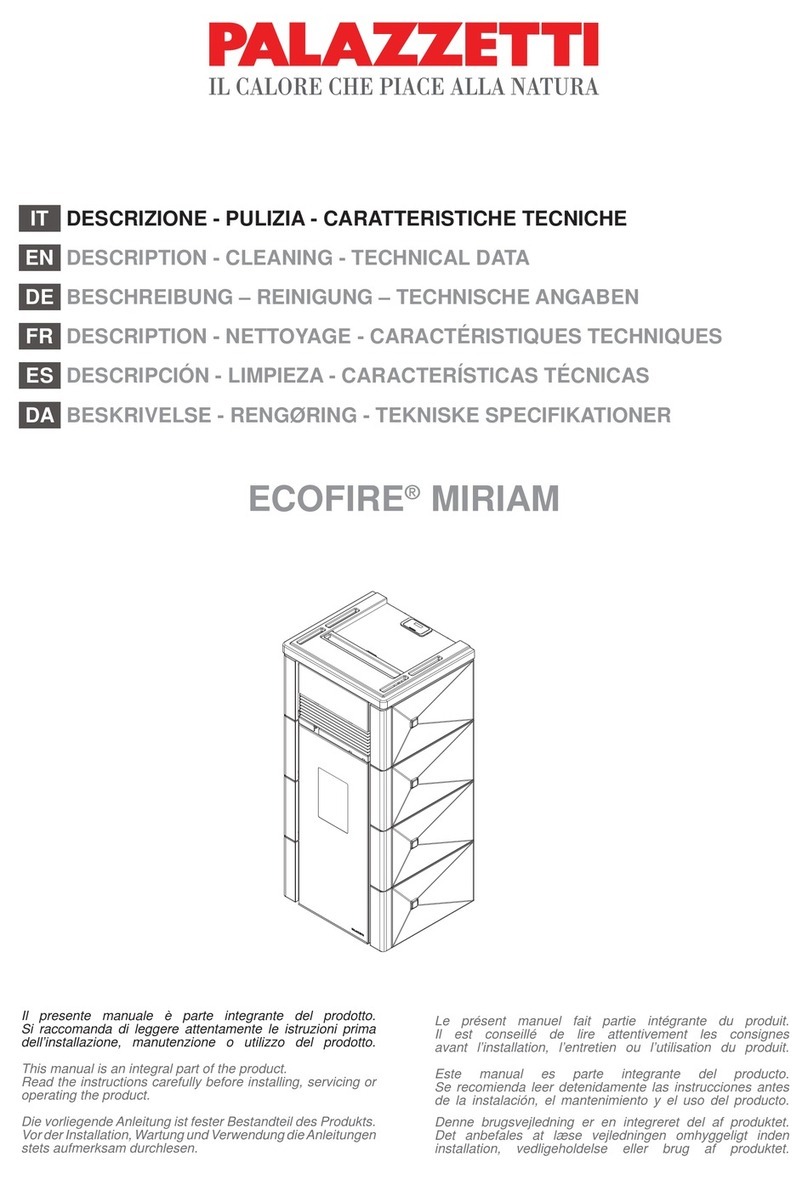
Page 5 / 31
CAUTION: DO NOT CONNECT TO ANY AIR DISTRIBUTION DUCT OR SYSTEM. NEVER USE
GASOLINE, GASOLINE TYPE LANTERN FUEL, KEROSENE, CHARCOAL LIGHTER FLUID, OR
SIMILAR LIQUIDS TO START OR FRESHEN UP A FIRE IN THE HEATER. KEEP ALL SUCH LIQUIDS
WELL AWAY FROM THE HEATER WHILE IT IS IN USE. DO NOT BURN GARBAGE OR FLAMMABLE
LIQUIDS SUCH AS GASOLINE, NAPHTHA OR ENGINE OIL.
HOT WHILE IN OPERATION! KEEP CHILDREN, CLOTHING AND FURNITURE AWAY FROM THE
HEATER. CONTACT MAY CAUSE SKIN BURNS. YOUNG CHILDREN SHOULD BE SUPERVISED
WHEN THEY ARE IN THE SAME ROOM AS THE STOVE.
Introduction
PELLET QU LITY:
Pellet quality is important, please read the following:
Your pellet stove has been designed to burn wood pellets only. Do not use any other type of fuel, as this will
void any warranties stated in this manual.
The performance of your pellet stove is greatly affected by the type and quality of wood pellets being burned.
s the heat output of various quality wood pellets differs, so will the performance and heat output of the pellet
stove.
CAUTION: It is important to select and use only pellets that are dry and free of dirt or any impurities such as
high salt content. Dirty fuel will adversely affect the operation and performance of the unit and will void the
warranty. The Pellet Fuel Institute (P.F.I.) has established standards for wood pellet manufacturers. We
recommend the use of pellets that meet or exceed these standards. Please use a recommended pellet type.
P.F.I. PELLET ST ND RDS:
Fines (fine particles)......by weight: no more than 0.5% maximum through a 1/8” screen
Bulk Density..................40 pound per cubic foot minimum Siz
e:
1⁄4”
to 5/16” diameter
1⁄2
to
11⁄2”
long maximum
sh Content.................1% maximum (Premium grade)..................3% maximum (Standard grade)
Moisture Content..........8% maximum
Heat Content................approximately 7,500-9,000 BTU per pound
PELLET FEED RATES: Due to different fuel densities and sizes, pellet feed rates may vary. This may require
the air intake damper setting (located where the intake air pipe meets the combustion chamber) to be adjusted.
To access, remove left rear panel by removing wing screws inside hopper. Increase airflow if the flame is
orange and lazy, and decrease airflow if pellets are “jumping” around or out of the burn pot. DO NOT OVER
FIRE. The adjustment range of the damper must not be altered for any reason. Since stove supplier has no
control over the quality of pellets that you use or installation and heating demands, we assume no liability for
your choice in wood pellets or the stove’s performance. Store pellets at least 36” (1 m) away from the pellet
stove in a dry place.
SHES:
Disposed ashes should be placed in a metal container with a tight fitting lid placed on a non-combustible floor
or on the ground, well away from all combustible materials pending final disposal. If the ashes are disposed of
by burial in soil or otherwise locally dispensed, they should be retained in the closed container until all cinders
have been thoroughly cooled.
The ash content of the fuel and operation of your stove will directly determine the frequency of cleaning. The
use of high ash fuels may result in the stove needing to be cleaned daily. low ash fuel may allow longer




























